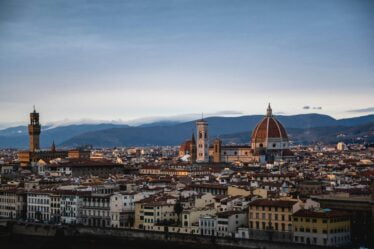

The Bell of Bargello is a name that resonates with mystery, history, and a touch of fear. This isn’t just any bell — it’s a voice from another time, a bronze echo that tells the story of a Florence once ruled by strict laws, sudden military summons, and destinies broken under the harsh midday sun.
Today, visitors can admire the Bell of Bargello inside the Torre Volognana, one of the towers of the iconic Bargello Museum, a must-see in Florence. But few know the curious and somewhat controversial origins of this bell.
A bell with a stolen past
The bell carries a peculiar name, “Montalina” — or as some still call it, “Montanina.” This name holds a hidden tale of what we might call a historical theft. The bell originally came from Montale, a peaceful village in the province of Pistoia. It was… let’s say, “borrowed” by the Florentines, but without any intention of returning it.
Once brought to Florence, the bell was given a far darker role than it likely ever had in Montale.
Cosimo I’s ruthless order
It was none other than Cosimo I de’ Medici, the powerful Grand Duke of Tuscany, who decided the fate of the Bell of Bargello. Known for his iron rule and obsession with order, Cosimo assigned the bell a very specific and chilling task.
Every day — at 10 am in winter and at midday in summer — the bell would ring. But this wasn’t just a reminder of the time; sundials took care of that. No, the sound of the Bell of Bargello was a warning, a signal that sent shivers down the spine.
The bell became infamous as “the bell of arms.” Why? Because according to a ducal law, any servant found carrying weapons without permission after the last bell toll would face a brutal punishment: the amputation of a hand.
This severe decree was an effective way to maintain order in a city that was always simmering with tension and rebellion.
A sound of fear and fate
But there’s more. The gloomy toll of the Bell of Bargello wasn’t just for curfew or military rules. Its ringing also meant the summoning of the army or the grim announcement of a public execution.
For the citizens of Florence, hearing the bell was never good news. Each toll carried the weight of fate, punishment, and fear. It became a sound deeply woven into the city’s collective memory.
This heavy presence in Florentine life even inspired a famous local proverb:
“Ha la lingua lunga come la campana del Bargello: quando suona, suona sempre a vituperio.”
(“Has a tongue as long as the bell of the Bargello: when it rings, it always rings for disgrace.”)
In short, the Bell of Bargello never spoke in vain. Whenever it sounded, it did so to announce something serious — something irreversible.
An echo still heard today
Today, as you visit the Bargello Museum, climb the Torre Volognana, and gaze upon the Bell of Bargello, it’s almost possible to hear that heavy, mournful sound echoing through the medieval stone walls.
It’s a sound that once shaped the destiny of Florence and left an indelible mark on the lives of countless citizens.
If you’re curious about more dark or mysterious stories of Florence, don’t miss:
- The Secrets of Palazzo Vecchio – Discover more
- The History of Piazza della Signoria – Learn more
- Discover the Bargello Museum – Plan your visit
- Florence’s Medieval Towers – Explore here
Conclusion
Whether you’re a history enthusiast, a curious traveler, or someone passionate about Florence’s hidden past, the Bell of Bargello remains a fascinating symbol. Its echo may no longer call armies or announce executions, but it continues to whisper stories of a Florence made of power, fear, justice, and resilience.



